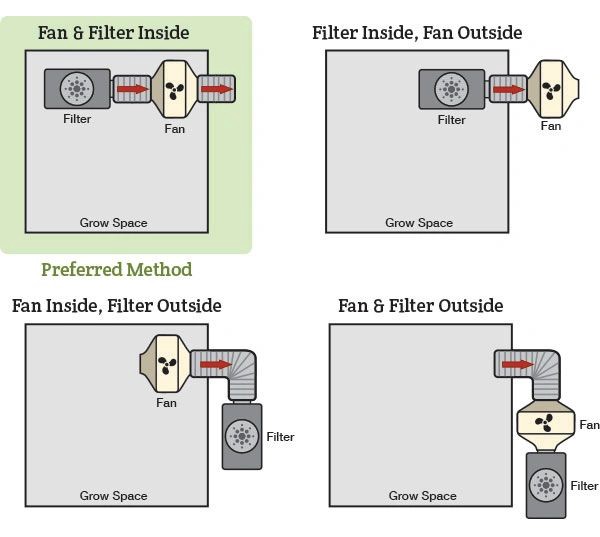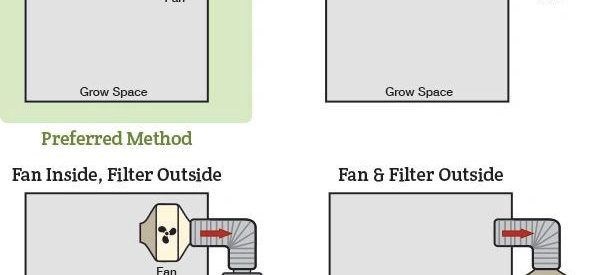What Is Grow Room Ventilation?
A grow room ventilation is a system that ensures a continuous flow of air between the outside world and the indoor grow area. It also includes some mechanism for keeping airflow inside the grow room.
How Does a Ventilation System Affect Plants
The main focus of a grow room is to provide plants with a better growing environment than outdoors. This also means providing fresh, CO2-rich air.
A ventilation system is crucial to keep the CO2 content inside the grow room at optimal levels for the plants. As the concentration of CO2 in the atmosphere is low, a constant flow of fresh air from outside is necessary.
Plants are used to growing in the outside weather, exposed to the wind and elements. When they are deprived of these conditions, it can affect them in unexpected ways.
Check out the following section to learn why ventilation system is essential for plants in an indoor grow room.
How to install an exhaust fan in a grow tent?
Determine Ventilation Setup

Now it is time to get your grow tent ventilation setup. This is often the part where most people have trouble, but it?s quite simple! There are several common grow tent ventilation configurations, but we recommend hanging the fan and filter inside the tent. For small to mid-sized carbon filters, this is the best solution.
It maximizes growing footprint and draws the air in through the filter. This allows the air to move slower, increases the overall effectiveness of odor control, while removing the hottest air from the top of the tent.
If your carbon filter is too large to hang from the ceiling of the tent, place it on the floor inside the tent if possible. This is not optimal, because your filter may draw more warm air down to plants when it is active, and it will take up valuable floor space. Sometimes, however, placing your filter on the floor is your only option.
Placing the filter and fan outside the tent is the least desired option. While it saves space, it has two main drawbacks. It pushes air through the filter at higher speeds, reducing the effectiveness of the filter for odor control. It also increases fan noise, since the ventilation is located outside the tent.
This solution is only used with very large carbon filters and when placing the filter on the floor is not an option. Before you begin, you should check out our complete guide on grow room atmosphere and ventilation. This will teach you everything you need to know about your grow room environment.
What size exhaust fan do I need?
Your aim is to completely turn over the entire volume of air in the grow room every 1?3 minutes (quicker is better). Fans are rated in CFM or Cubic Feet per Minute.
Simply determine the cubic feet of your space (like 2 ft X 6 ft X 8 ft tall) 2x6x8= 96 cu ft.
Then get a fan rated at 96 CFM or more and you?re good to go.
4″ fans and ductwork is fine.
But don?t buy one of these, with the clear plastic blades, no matter what they claim. It does NOT move air well.
5 steps to setting up your ventilation system
For LED grow light , CMH grow light and Fluorescent grow light users, you won?t have a reflector you?ll have to connect to. Setup couldn?t be easier for you guys.
- Step 1. Attach your inline fan to one of the extra ceiling bars that your marijuana grow tent most likely came with ? adjustable rope clip handles work great as you fan will hang only a few inches from the ceiling.
- Step 2. Either slide the inline fan over to fit into an exhaust hole or even easier connect your inline fan to the ducting which can be run through and out an exhaust hole.
- Step 3. Hang your carbon scrubber ? it most likely will come with ropes for hanging.
- Step 4. Attach the carbon scrubber to the inline fan so that the fan is pulling air through the scrubber ? you can use ducting or simply connect them if they are the same size.
- Step 5. Confirm your components are the in proper order: Outside air is passively pulled in through the bottom intake ports up into the filter (passing air through the lights), which then moves the air through the inline fan and out the exhaust holes.


